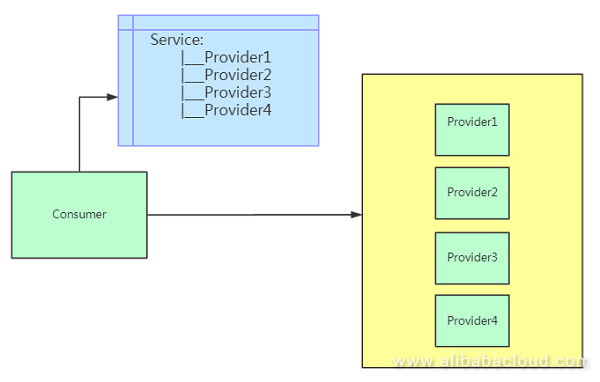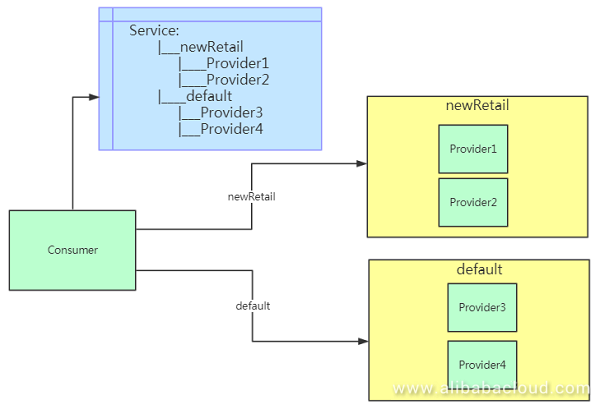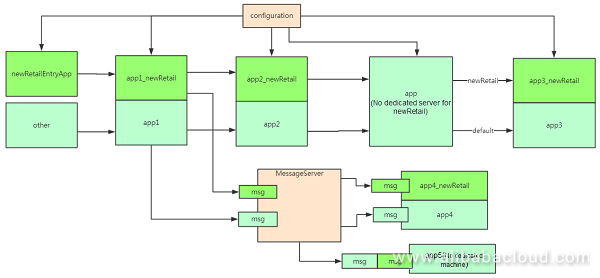The Alibaba Cloud 2021 Double 11 Cloud Services Sale is live now! For a limited time only you can turbocharge your cloud journey with core Alibaba Cloud products available from just $1, while you can win up to $1,111 in cash plus $1,111 in Alibaba Cloud credits in the Number Guessing Contest.
By Alibaba Middleware Aliware Team
During this year's Double Eleven Shopping Festival, technical preparations had to be changed from previous years to support New Retail. The Business Division required that traffic from new retail will enter independent servers and be isolated from other common traffic. Although conceptually straightforward, this poses higher requirements on the stability of new retail systems.
We have proposed a solution known as Dpath (dedicated path) to cope with these new requirements. The general idea of Dpath can be described as follows:
We'll introduce how Dpath works in three steps:
Simply put, the information we need is the machines, apps, and the relation between them in a dedicated environment. Such information is stored in the configuration center in JSON format. A sample are as follows:
{
"enable": true,
"envRules": [
{
"envName": "newRetail",
"failoverPolicy": 0,
"envAppRules": [
{
"appName": "app1",
"ips": [ ],
"machineGroups": [
"app1_newRetail_host"
]
},
{
"appName": "app2",
"ips": [ ],
"machineGroups": [
"app2_newRetail_host"
]
},
{
"appName": "app3",
"ips": [ ],
"machineGroups": [
"app3_newRetail_host"
]
},
{
"appName": "newRetailEntryApp",
"ips": [ ],
"machineGroups": [
"newRetailEntryApp_host"
]
}
]
}
]
} The above configuration information describes a dedicated environment called newRetail, which has four apps, app1, app2, app3, and newRetailEntryApp, and their corresponding machines.
The Dpath toolkit subscribes to the configuration, and each middleware can use the Dpath toolkit to get the required information.
Dpath uses the dpath_env attribute carried by the trace module (the trace function of the entire link, which can transmit data on the link) to identify the corresponding dedicated environment for the current traffic. With regards to how to map a request information to a dedicated environment, the business division will do it with business logic. This identification can be done by any one of the following three methods:
Method 1: Nginx
Identifies traffic based on http request information. Maps the request to dpath_env in accordance with business rules, and adds the env information that is generated by the Nginx module to the context of the trace module.
Method 2: Entry App
If the environment information retrieved by the middleware is null, then the current environment information of the current machine will be used by default. So after determining the entrance app, simply include the entire entrance app to the dedicated network. All new retail apps use this model currently.
Method 3: Business Code
The business code can set the dpath_env in the context of the trace module as needed, and change the environment of the traffic at any time.
Dpath only defines the relationship between machines, environments, and the traffic, and does not specify how to direct traffic. Traffic direction is implemented by the middleware.
Here we take RPC as an example to describe how to direct traffic to the corresponding servers based on the Dpath rules.
To make it easier to understand, we will ignore other routing logic of RPC, and take a look at the processing of a single call in the simplest case. Without DPath, the RPC client gets the list of servers that are corresponding to the service from the registration center, and then calls these servers randomly. As shown in the following picture:

After we incorporate the Dpath function, a dpath_env logic is inserted into the mapping between the service name and the server. The RPC client first selects the addresses of the corresponding environments according to the environment information in the request context, and then calls them randomly. As shown in the following picture:

On the entire link, dedicated servers of all apps in a dedicated environment are connected to form a dedicated path for special traffic.

As shown in the picture above:
In addition to RPC, middleware products such as message-oriented middleware (MOM) have achieved similar isolation effects using their respective ways. The details will not be described here. A brief effect diagram of RPC and message-support Dpath is shown as follows:

Based on the above description, the RPC isolation logic takes effect on the client side. Then, if the clients are not upgraded (it is difficult to quickly coordinate all clients to upgrade uniformly), unknown traffic may be directed to the dedicated servers. Non-conforming traffic sent by non-upgraded clients is called wild traffic.
In order to address the wild traffic issue, developers of the registration center provide a namespace function based on the publishing - subscription function. We will publish services of dedicated servers to the "DPath" namespace, and services of common servers to the "default" namespace by default. Latest clients will subscribe to the data of both default and dpath namespaces, which is equivalent to getting the full address. The registration center ensures that the non-upgraded clients can only see data in the default namespace, so that there will be no wild traffic reaching the dedicated servers.
Dpath is a universal traffic isolation solution that supports scenarios that need to isolate or direct traffic, such as normal isolation, A/B testing, and blue-green release.
So far, the business division mainly conducts normal traffic isolation on the entire link according to service attributes. This has been used on several new retail scenario lines, and has been successfully implemented during the Double Eleven Shopping Festival.
Some benefits of service traffic isolation are as follows:

2,599 posts | 764 followers
FollowAlibaba Clouder - September 23, 2020
Alibaba Clouder - June 28, 2020
zhugejin - March 5, 2020
Alibaba Developer - August 24, 2021
Alibaba Developer - March 8, 2021
Alibaba Clouder - October 30, 2018

2,599 posts | 764 followers
Follow Black Friday Cloud Services Sale
Black Friday Cloud Services Sale
Get started on cloud with $1. Start your cloud innovation journey here and now.
Learn More E-Commerce Solution
E-Commerce Solution
Alibaba Cloud e-commerce solutions offer a suite of cloud computing and big data services.
Learn MoreMore Posts by Alibaba Clouder
Raja_KT February 15, 2019 at 4:39 am
Will not the routing be eating the latency? Of course, when the product is seen , more questions.